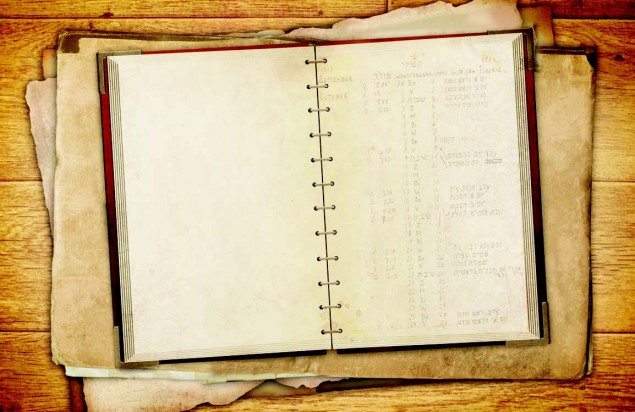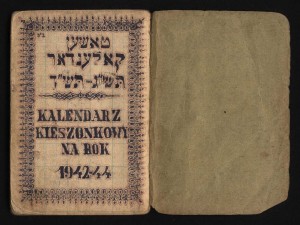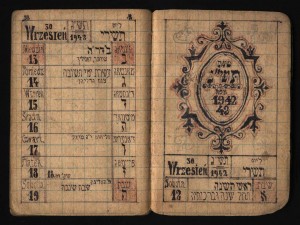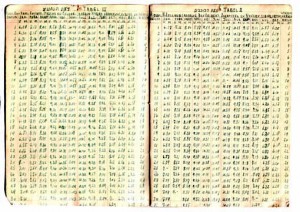On Calendars And the Holocaust
By Avraham Rosen

Digitally adjusted image of the calendar Rabbi Yehoshua Neuwirth, author of Shemirat Shabbat Kehilchata, created when he was seventeen years old while hiding in a bunker in Amsterdam during the war years. Courtesy of Rabbi and Rebbetzin Yehoshua Neuwirth, with the assistance of Dr. Esther Farbstein
The threat to the calendar and the concomitant threat to Jewish life is nothing new in Jewish history. Speaking passionately about the shift to a fixed calendar brought about by Roman persecution some 1,700 years ago, Rabbi Yissocher Frand, senior lecturer at Ner Israel Rabbinical College, details what was at stake:
If it wouldn’t be for Hillel, literally we would be out of business; we wouldn’t have a Yiddishkeit.
Because we can’t have a Yiddishkeit without a calendar, and we can’t have a calendar without a Sanhedrin. 1
The Jewish calendar, marking Shabbat, chagim and Rosh Chodesh, is clearly one of the institutions at the heart of Jewish life and survival.
The upheaval of the Holocaust, which destroyed much of European Jewry between the years 5699 and 5705 (1939-1945), also wreaked havoc on Jewish timekeeping. From early on, as we know, the persecutors uprooted Jewish communities and deprived them of basic physical and cultural necessities. This scourge of material resources reached its zenith in the concentration camps, which, according to Yaffa Eliach, a professor of Holocaust studies, “placed men outside the sphere of societal time and place.”2 Bereft of virtually all personal items, the victims’ “time-consciousness” suffered as well. It often became impossible simply to keep track of the day’s date.
To a degree, the devastation of time during the Holocaust has come under scrutiny, with scholars telling how wartime Jewry was often compelled to invent new terms to characterize their brutal circumstances. But attention to the calendar’s role in this period has suffered in the bargain, probably because the calendar suggests normalcy, regularity and order, while the upheaval of the Holocaust ushered in exactly the reverse. When referred to at all, the Jewish calendar has been mainly cited as subject to German abuses, as notorious actions were planned to take place on Shabbat and chagim. While these factors indeed played a role, the preciousness of the calendar has been overlooked.
A sense of this preciousness actually predated the beginning of the war. In Elul 5699 (August, 1939), for example, Vilna-based Yehoshua Baran, acting with a premonition that the looming conflict would go on for years, produced a ten-year Jewish calendar.3 Recalling the chaos of the Great War and the ensuing difficulties of time keeping, he hoped that such a stopgap measure would help maintain some control amidst the hell that was sure to come. The copy of Baran’s calendar which I viewed in the Yad Vashem Archives was given to the donor in the Bad Salzschlirf German DP camp in 1947, intact except for one missing page—a clear sign that Baran’s judgment was on target as his calendar was in use from 1939 until 1947.

Cover of the calligraphic calendar Rabbi Yosef Scheiner prepared while hiding in his rescuer’s home in Dombrova, Poland, from 1943 until the end of the war. Courtesy of Rabbi Yisrael Scheiner, with the assistance of the Yad Vashem Museum.
In the ghettos of Eastern and Central Europe, a semblance of Jewish communal life was maintained, even while conditions often made attention to the calendar difficult and dangerous. Calendars were at times official publications of ghetto authorities and at other times circulated by rabbinic figures. Lodz, for instance, published a Jewish/Gregorian calendar bearing a photograph of the “Elder of the Jews,” Chaim Rumkowski, whose authoritarian, self-promoting rule of the ghetto was questioned by many. Yet, for all its kowtowing to questionable authority, the ghetto calendar not only gave candle-lighting times for Shabbat and chagim, but also listed the beginnings and ends of the fast days—this at a time when many in the ghetto were forced to live at starvation levels. Such details made traditional observance the default mode of viewing reality; the ghetto’s atrocious conditions did not erode a single iota of the ideal of Jewish sacred time.
In Lublin, Rabbi Tzvi Elimelech Talmud, a former student of Yeshiva Chochmei Lublin and a major rabbinic voice in the city, published a calendar for 5700 and then again for 5703, the latter handwritten and composed in the wake of the deportation of most of the Lublin Ghetto’s Jews. To bring forth such a calendar at this juncture not only enabled observance for those who remained, but also envisioned, nay virtually created, a future. Rabbi Talmud undertook this task as he, in the painful absence of the former chazzanim, prepared to lead yomim tovim prayers for the first—and alas, final—time.4
In hiding and in the camps, Jews could no longer count on the community or the rabbis to help them keep track of time. Most fared as best they could; some were helped along by friends or mentors, yet others produced calendars on their own.

Inside view of Rabbi Scheiner’s calendar, a meticulous guide to Jewish life which he crafted in the midst of carnage. Courtesy of Rabbi Yisrael Scheiner, with the assistance of the Yad Vashem Museum.
For Shlomo Yosef Scheiner in Poland and Yehoshua Neuwirth in Holland, the making of calendars while in hiding created a Jewish domain whereby tradition could live and flourish. Rabbi Scheiner, a chassid of the Neustadter Rebbe, ran a flour mill as well as a brick and roof tile factory in Dombrova, Poland before the war. He, his wife, and four children lived in nearby Pinczow. The Pole who would become his rescuer during the war, Franciszek Matjas, was an employee of the Scheiners’ who had built his home thanks to a loan from his boss. In early 1943, after two months spent hiding in the forest, the Scheiner family hid in the Matjas’ home in Dombrova behind a wall that Scheiner and Matjas built inside the house. While in hiding, Rabbi Scheiner prepared a calendar according to his own calculations.5
The Jewish calendar, marking Shabbat, chagim and Rosh Chodesh, is clearly one of the institutions at the heart of Jewish life and survival.
Scrupulously noting Shabbat, chagim, Rosh Chodesh, and the precise time of sunset that ushered in these special days, Rabbi Scheiner at first only schematically set down these calculations. But the final product, rendered in a checkerboard notebook, was a full-blown, beautifully calligraphed calendar, with equal finesse being given to the Hebrew, Yiddish, and Polish names and dates. And even the nuanced errors that crept into the definitive version—mistaking tzeit hakochavim for the time of shkiah, for example—testify to the remarkable pains taken to craft a meticulous guide to Jewish life in the midst of carnage. The calendar also doubled as a kind of diary. On a number of dates Rabbi Scheiner noted, in red-inked Yiddish script, tragic events that had occurred to neighbors and friends. The Scheiner family was gratefully liberated in January 1945 by the Red Army, and returned to Pinczow to find that the streets were empty of Jews.
At roughly the same period in Western Europe, Rabbi Yehoshua Neuwirth, renowned in the postwar world for his book Shemirat Shabbat Kehilchata, spent the war years in Amsterdam in hiding with his parents. He was twelve or thirteen when the war began. The Neuwirths were based in Berlin in the 1930s, but after Kristallnacht they sent their three sons, including Yehoshua, to Antwerp, where the latter celebrated his bar mitzvah with a foster family. Their parents soon fled Germany as well, and the family was reunited in Amsterdam, where they eventually went into hiding. Somehow they escaped even the final “action” in fall 1943.6
Yehoshua Neuwirth was around seventeen years old when he made a calendar, which he did both to keep busy and also to keep track of time. While in hiding, writes Rabbi Neuwirth, “there was not in our possession a calendar according to which we could know the days of the holidays.” Relying on one of the few sacred books in the bunker as a guide, he was able to construct a Jewish calendar from scratch, and fashioned a calendar “for the years they were in hiding” with “the times and days of Shabbatot and holidays and also fast days.” The multi-year calendar ended up circulating outside the family’s hiding place, since word of its existence spread to the Dutch Jewish Underground, which took steps to photograph it and disseminate the reproductions to Jews in camps.
Rabbi Neuwirth’s efforts had their near parallel in a hand-written calendar for 5703 (1942-1943) produced by a senior figure in the Amsterdam Jewish community, Rabbi Shimon Hammelburg.7 Born in 1884, Rabbi Hammelburg was noteworthy for his translation of the Mishnah into Dutch. He served as a member of the Amsterdam chevra kadisha and as a teacher in an Amsterdam yeshivah, and was apparently well known for his calendrical prowess. In Rabbi Hammelburg’s case, however, the 5703 calendar was tragically his last. He was deported to the Sobibor death camp and murdered there on June 4, 1943/Rosh Chodesh Sivan, 5703. His meticulous calendar thus eerily included the day of his own demise.
In the labor and concentration camps, keeping track of days was an especially daunting task, either because no calendar was at hand, or because the effort was simply too great. Even though Rabbi David Kahane, imprisoned in the brutal Janowska camp in Lvov, had a fifty-year calendar in his possession, he did not have the wherewithal to keep track of time. Only when he checked the calendar to find the date on which two friends had been murdered did he realize the day’s significance. “Suddenly I remembered: ‘Master of the Universe, wasn’t today the first light of Chanukah, Thursday evening, the onset of the twenty-fifth day of Kislev? The first light of Chanukah, and I had forgotten.’”8

Relying on one of the few sacred books in the bunker, Rabbi Neuwirth was able to construct a calendar from scratch with the times and days of Shabbatot and holidays as well as fast days. Courtesy of Rabbi and Rebbetzin Yehoshua Neuwirth, with the assistance of Dr. Esther Farbstein.
In a number of cases, one person with a superhuman capacity for tracking the calendar would assist others who had no idea of the day or date. Bertha Ferdiger-Salz reports her extraordinary meeting with an old dying woman in Bergen-Belsen reciting Gott fun Avraham. Drinking in her words, Ferdiger-Salz asked, “How did she know when it was Shabbat?” The remarkable reply was that the woman had arrived recently from Hungary and since then she had each day made a knot in her dress. 9
In Buchenwald, one Gerrer chassid shared with another the secret of the submerged calendar date. “He whispered in my ear, ‘Shalom, David. I wanted to tell you that today is Purim.’ By this time I no longer knew the date, and in fact I was amazed that he did. He gave me mishlo’ach manos, too—a saccharin pill he had somehow gotten hold of.”10
Like the daily knot in the dress of the Gott fun Avraham woman in Bergen-Belsen, others also took it upon themselves to keep track of time. For some, memory alone played this role. In Dachau, Rabbi Feschhoff from Prague “had the whole Jewish calendar written in his head; he knew when every festival and every observance fell out. Now he informed us that Chanukah would begin in another week, so we must get ready.”11 Though printed calendars were occasionally smuggled into camps, more often one learns of calendars made from scratch. This was the case, for example, with the Dutch Rabbi Avraham Shlomo Levisson, who composed a calendar for 5704 in Bergen-Belsen, where toward the end of that year the concentration camp’s population nearly doubled, and where in the weeks before the war’s conclusion, Rabbi Levisson would be sent to his death.12 Similarly, the Polish Rabbi Yaakov Avigdor fashioned a calendar in Buchenwald in 5705, and, having survived the war, later reflected on undertaking this enterprise in such unfavorable conditions.13
Not only rabbis or learned men tracked time, however; knowledgeable women and girls also followed suit. In a work camp in Leipzig, for instance, the Radoschitz Rebbe’s daughter, seeing other girls at a loss about chagim, composed a calendar that could be completed only when her father, no longer of this world, communicated to her in a dream the day of the week on which Pesach fell.14 And in Auschwitz, a teenage girl, Anna Berinski, fashioned a Hebrew and German calendar, flanked by passages from the siddur and Pirkei Avot; together the holy days and words created an alternative reality far more enduring than the camp setting in which they came into being.15
Whether by carrying out colossal acts of memory, scripting a makeshift calendar, or tying a daily knot in ragged cloth, these Jews sought to harness time to Torah, so that even in the ravages of the Holocaust, one could know how to serve the Almighty—or, at the very least, when.
Dr. Avraham Rosen, author and editor of a number of books on Holocaust literature and testimony, is currently at work on a study entitled “Killing Time, Saving Time: Calendars and the Holocaust.”
Notes
1. Rabbi Yissocher Frand, audio tape #015, “Reinstituting the Semichah.”
2. “Jewish Tradition in the Life of the Concentration-Camp Inmate,” The
Nazi Concentration Camps, ed. Y. Guttman and A. Saf (Jerusalem, 1984), 196.
3. Yad Vashem Archives; Dr. David Silberklang, editor of Yad Vashem Studies, personal communication.
4. Dr. Silberklang, personal communication, Nissan 5768.
5. Rabbi Yisrael Scheiner, interview by the author, Shevat 5771; Sara Shor, Registrar, Yad Vashem Museum Artifacts Collection, and Michael Tal, Artifacts Curator, Yad Vashem Museum; on the Matjas’ rescue of the Scheiners in wartime Poland, see Rescuers of Jews during the Holocaust, Israel Gutman et al, (Jerusalem, 2004).
6. Rabbi Yehoshua Neuwirth, “Introduction,” Shemirat Shabbat Kehilchata, rev. ed.; Rabbi and Rebbetzin Y. Neuwirth, interview by the author, Shevat 5771; Tuvia Freund, “The Forced Desecration That Led to Shmiras Shabbos: An Interview with Harav Yehoshua Neuwirth,” Hamodia, 25 March 2010, 7-9; Yosef Roosen, personal communication, fall 2010; Nechama Shirkin (daughter of Rabbi Neuwirth), personal communication, January 2011; Tuvya Ferschel, HaDo’ar, 9 (Tishrei 5727): 643, excerpted in Shema Yisrael: Testimonies of Devotion, Courage, and Self-Sacrifice, 1939-1945, Yaakov Lavon, trans. (Bnei Brak, 2002), 91.
7. Bernard Hammelburg (grandson of Rabbi Hammelburg) and Dr. Jehuda van Dijk, personal communication, Shevat 5771; Tuvya Ferschel, HaDo’ar, 9 Tishrei 5727, 643, excerpted in Shema Yisrael, Yaakov Lavon, trans. 91.
8. Rabbi David Kahane, Yoman Ghetto Lvov (Jerusalem, 1978), 119.
9. Bertha Ferdiger-Salz, Un di zun hot gescheint (Tel Aviv, 1965), 134-135.
10. Shema Yisrael, Yaakov Lavon, trans. 207.
11. Ibid., 210-211.
12. Esther Farbstein, Hidden in Thunder: Perspectives on Faith, Halachah, and Leadership during the Holocaust (Jerusalem, 2007) 351.
13. Dr. Riki Bodenheimer, archivisit, Yad Vashem, personal communication.
14. Yechiel Granatstein, One Jew’s Power, One Jew’s Glory: The Life of Rav Yitzchak Shumuel Eliyahu Finkler the Rebbe of Radoschitz in the Ghetto and Concentration Camp (Jerusalem, 1991).
15. Shor and Tal, personal communication; Dr. Bodenheimer, personal communication.
